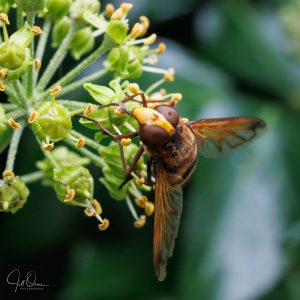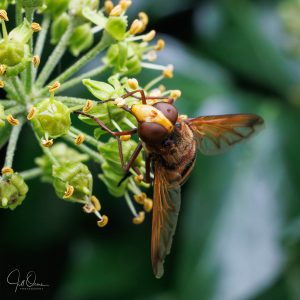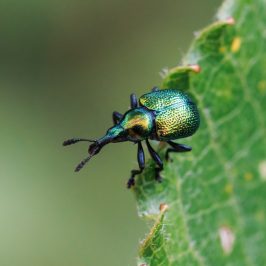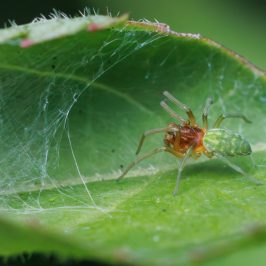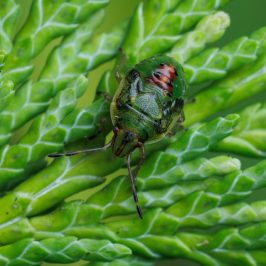It was a pretty bleak day, and my equally dour mood wasn’t improved by the realisation that the ivy is now coming into flower. This is almost the last gasp of summer, and means that autumn is just around the corner. What with one thing and another I’ve had a relatively poor invertebrate season, and the only thing that cheers me about the looming invert off-season is the hope that the Short-eared Owls might come back to spend another winter on the Cotswold scarp.
Anyway, I pulled myself together and went to investigate the ivy on our side fence – cautiously, I have to say, because it was swarming with Common Wasps, and they can be a little unpredictable at this time of year. There were also numerous honey bees taking advantage of the sudden bounty, and I think it was one of these poor creatures that was grabbed by a huge Hornet, decapitated and dewinged, and carried away, presumably to feed the growing larvae in a nearby nest. All of this drama happened so fast that I didn’t even have time to think “settings?”, let alone lift the camera, which is why I’m not certain of the victim’s identity.
I am pretty certain though that it wouldn’t have been one of these, which is a female Hornet Hoverfly (Volucella zonaria). European Hornets are between 25 and 35mm long – queens being bigger than workers and males – and Hornet Hoverflies are around 20mm. While Hornets will attack and kill many different kinds of insects, including beetles and even small dragonflies, they generally have to land to dissect larger prey items before carrying them away, and while a 12mm honey bee wouldn’t present any logistical difficulty, a Hornet Hoverfly would have been much harder to deal with.
Hornets are generally placid creatures, unless you’re on their menu or threatening their nest, and their bright red and yellow colouration is really a kind of bluff, designed to make predators think that they’ll be unappetising. Unfortunately this doesn’t work with humans, many of whom are frightened of Wasps, and assume that being twice the size, Hornets are twice as dangerous. The entirely defenceless Hornet Hoverfly has evolved to resemble a Hornet in both size and colouring, which is a good defensive strategy in regard to the predators it faces in its usual woodland habitat, but sadly has tended to draw the attention of the kind of people who think that the only good Hornet is a dead one. Luckily though, thanks to increased public awareness of the importance of insects, and the easy availability of insect identification groups on social media, this gentle giant is now coming to be much better recognised.
I couldn’t resist posting a couple of other images today, because they show something I’d never seen before. If you look at the first extra full-screen, it shows the hoverfly dabbing pollen from the upper side of an anther, but in the second one she’s twisting her proboscis through 180°, to lick the under side. Maybe I’m just weird (yes, OK, thanks – I know), but I think this is awesome.


